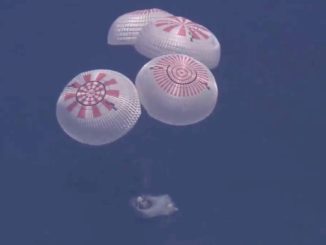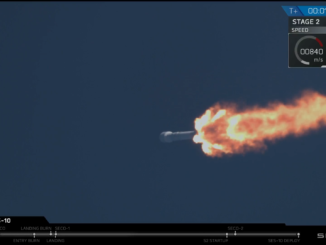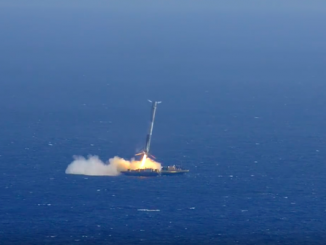EDITOR’S NOTE: The Falcon Heavy successfully launched on the STP-2 mission at 2:30 a.m. EDT (0630 GMT) on Tuesday, June 25.
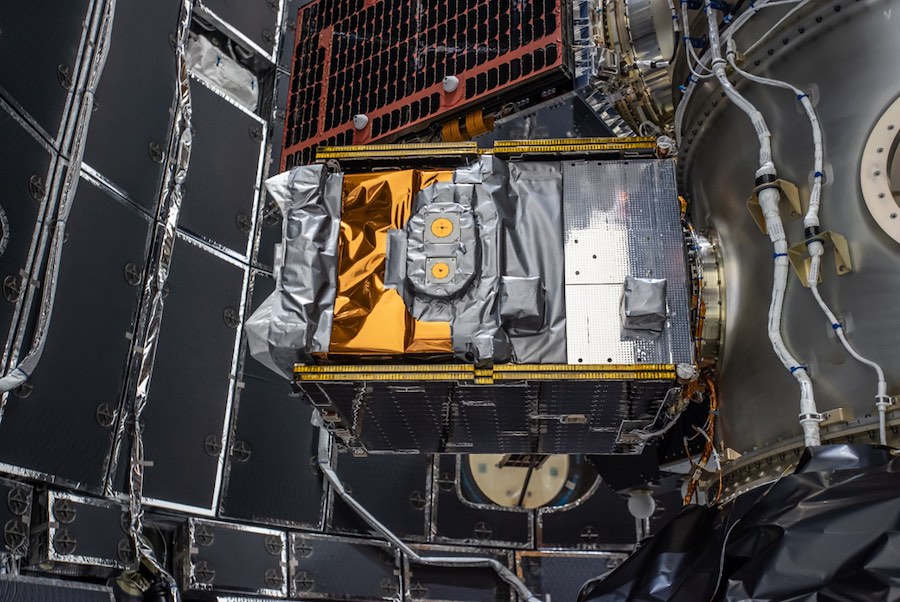
NASA is sending into orbit Monday night a spacecraft to test a safer type of rocket fuel, an ultra-precise atomic clock that could change the way missions navigate in deep space, and an experiment to examine the resiliency of electronics to radiation.
The NASA-funded missions are part of a package of 24 spacecraft awaiting liftoff Monday night aboard SpaceX’s Falcon Heavy rocket from the Kennedy Space Center in Florida.
The Falcon Heavy’s four-hour launch window opens at 11:30 p.m. EDT Monday (0330 GMT Tuesday). The rocket will lift off for the first time at night — and third time overall — with more than 5 million pounds of thrust from 27 Merlin main engines.
The rideshare mission is sponsored by the U.S. military’s Space Test Program, which oversees launches of the Defense Department’s experimental and technology demonstration satellites.
The STP-2 mission set for liftoff Monday night is carrying 24 spacecraft to three distinct orbits for the Air Force, NASA, NOAA, Taiwan and multiple universities.
Read our earlier story for details on the payloads and the Falcon Heavy’s complex launch profile to reach the three different orbits.
Six of the satellites on the STP-2 mission, developed in partnership between NOAA and Taiwan’s space agency, will collect profiles of atmospheric moisture, temperature and pressure for weather forecasters.
Other payloads on-board the rocket include a nanosatellite from the Planetary Society that will demonstrate a solar sail in orbit, a CubeSat from the U.S. Air Force Academy that will test a deployable telescope structure, and a housing that carries the cremated remains of more than 100 people.
NASA’s experiments set for launch Monday night will focus on new technologies aimed at making spaceflight safer and cheaper.
Green propellant offers safety and fuel-efficiency advantages
One of the NASA-funded satellites is named the Green Propellant Infusion Mission, or GPIM. Built by Ball Aerospace, the refrigerator-sized spacecraft will test a hydroxyl ammonium nitrate fuel and oxidizer blend called AF-M315E.
The propellant was invented by the Air Force Research Laboratory. The demonstrations planned on the GPIM mission could pave the way for future missions to use the fuel blend in place of hydrazine, a toxic propellant often mixed with nitrogen tetroxide, another hazardous chemical, to feed small maneuvering thrusters on-board satellites in space.
Aerojet Rocketdyne built the propulsion payload on the GPIM spacecraft. The thruster package is made up of five small engines to control the satellite’s orientation, and change its orbit.
“We’ve been very interested over a couple of decades in the development of this new green propellant, and we’re very excited today because we see a new and evolving marketplace, one that is looking at a lot more small satellites, even as small as Cubesats, that are going to have propulsion, which is something that traditionally, up until now, they haven’t had, and they could definitely benefit from this new propellant,” said Joe Cassady, Aerojet Rocketdyne’s executive director of space.
The Falcon Heavy will release GPIM in the second of three orbits on its three-and-a-half hour mission. GPIM, along with several other satellites, will be deployed into a circular orbit 447 miles (720 kilometers) above Earth, with an inclination of 24 degrees to the equator.
Once deployed from the Falcon Heavy, the 348-pound (158-kilogram) GPIM spacecraft will unfurl its solar arrays to start generating power, then prime its “green” propulsion system to begin in-space maneuvers.
Some of the GPIM project’s goals have already been achieved.
Technicians loaded 31.3 pounds (14.2 kilograms) of the AF-M315E fuel into the spacecraft at Cape Canaveral a few weeks before launch. Crews that load hydrazine into satellites before launch must wear protective self-contained suits, while the technicians that fueled the GPIM satellite wore lab coats and gloves, said Chris McLean, the mission’s principal investigator from Ball Aerospace.
Teams shipped the fuel to the launch site via FedEx. The less stringent handling requirements could save up to $500,000 in pre-launch processing costs, according to McLean.
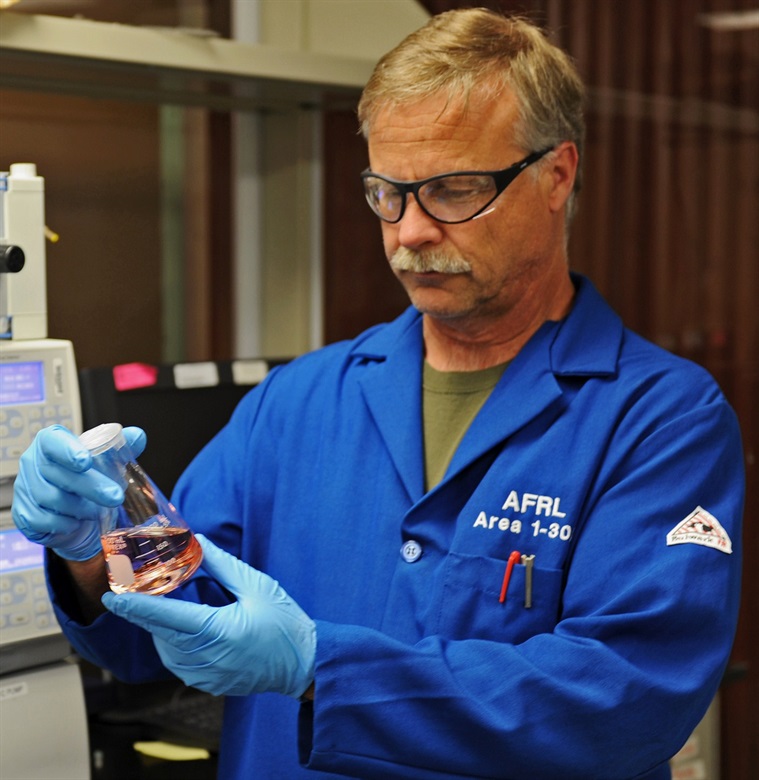
The AF-M315E fuel is more dense and viscous than hydrazine, which has a similar density to water. The non-toxic fuel on GPIM is more akin to a light motor oil, and has a peach color, McLean said.
That allows satellites to carry more fuel in the same volume.
“The other thing that strikes me on this propellant is the performance,” McLean said. “If I compare this to a standard monopropellant hydrazine system, we have 50 percent more total impulse available, mainly due the density of the propellant. So for a given tank volume, we’re able to squeeze in 50 percent more propellant, which means 50 percent more mileage for the spacecraft.”
The non-toxic fuel is also not prone to freezing in space like hydrazine, which requires heaters to stay warm enough to remain a liquid.
“Hydrazine fuel and some of the other hypergolic fuels that we use in spacecraft, they will freeze when the temperature gets below freezing,” McLean said. “It’s similar to water. It would mean, like the pipes in your house, the pipes would crack. In order to keep the spacecraft safe for a long mission, you have to apply heater power.
“This fuel does not do that,” he said. “It goes into what’s called a glass transition phase, so when it gets really cold, it just gets hard, and then when it warms up again, it comes out.”
Hydrazine is also a hypergolic fuel, meaning it combusts when mixed with other chemicals, like nitrogen tetroxide. The AF-M315E fuel requires hotter temperatures to ignite, making it safer to handle, but subject to more extreme operating conditions once in space.
Air Force engineers invented the AF-M315E fuel blend in 1998 at Edwards Air Force Base in California. One of the reasons it took so long to test the AF-M315E fuel in space was the hot temperature required to ignite the propellant.
“This looks a lot like a standard hydrazine monopropellant technology, except the material demands are extreme,” he McLean said. “Over the course of this program, we got the point where we got to an engine that could handle these excessive amounts of enegy successfully, over and over again, and we proved that through extensive ground testing at Aerojet Rocketdyne.”
Bradford ECAPS, based in Sweden, has also pioneered green propellants for satellites. The ECAPS fuel, named LMP-103S, has flown in orbit on Sweden’s Prisma technology demonstration mission, Planet’s SkySat Earth-imaging satellites and the U.S. military’s STPSat 5 experimental satellite.
The Swedish-developed fuel has many of the same advantages as the AF-M315E propellant, the U.S. fuel is more dense — which offers some technical advantages — and will help U.S. industry enter the green propellant market.
“Having a U.S. supplier of certain technologies is important to some of our customers, and I focus my energy there,” McLean said.
Cassady said Aerojet Rocketdyne wants to build prefabricated propulsion modules that use the new green propellant, and sell the hardware to small satellite builders and CubeSat manufacturers.
The GPIM demonstration, which NASA said is costing the space agency about $65 million, will be a “litmus test” for the new non-toxic fuel before customers start using it, according to Cassady.
GPIM also hosts several secondary experiments for the Air Force and NASA. The green propulsion system will reduce the satellite’s orbital low point, or perigee, to less than 200 miles (300 kilometers) over the course of the 13-month mission, then a final burn will position the spacecraft for a destructive re-entry back into Earth’s atmosphere.
New interplanetary timekeeper to aid deep space navigation
The Deep Space Atomic Clock hosted on-board the Orbital Test Bed satellite built by General Atomics is a pathfinder for future missions that could navigate on their own in deep space, according to NASA.
If successful, the ion-based atomic clock could lead to “GPS-like navigation” at other planets, said Jill Seubert, the experiment’s deputy principal investigator at NASA’s Jet Propulsion Laboratory.
“Tracking a spacecraft as it travels through space is fundamentally a problem of measuring time,” Seubert said. “We can’t just pull out a ruler and measure how far away our spacecraft is, so instead we measure how long it takes for the spacecraft to echo back a radio signal that is sent from Earth. The farther away a spacecraft is, the longer it takes for us to hear that echo from our Deep Space Network stations on the Earth.
To navigate spacecraft safely, we listen to that echo and measure that signal time to within one billionth of a second,” she said.
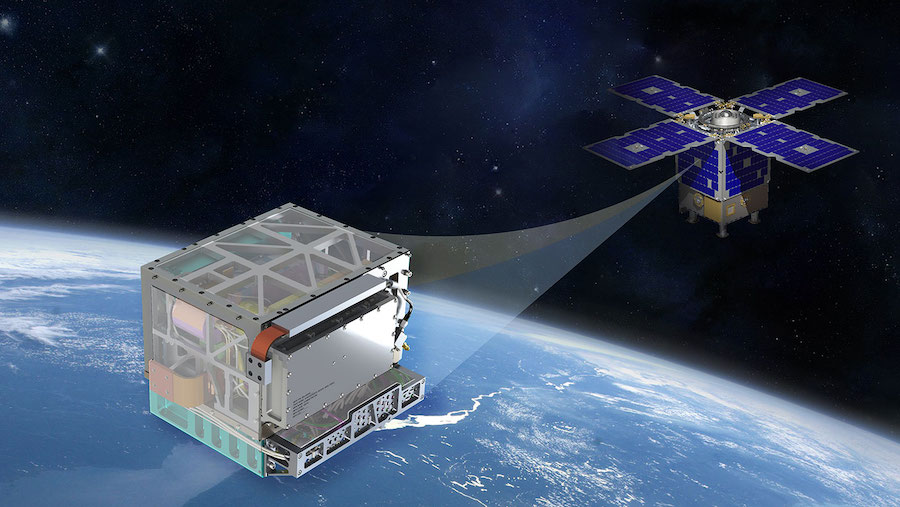
The Global Positioning System network uses the same technique. The GPS satellites each carry atomic clocks and transmit time-tagged radio signals to receivers on the ground. A computer algorithms calculates how long it took the signal to travel from the spacecraft to the receiver, and works out the user’s location through triangulation.
For deep space probes, ultra-precise clocks on the ground are used to time-tag radio signals transmitted from Earth to spacecraft millions of miles away.
“Historically, we’ve had to track spacecraft this way because clocks we’d need to measure that signal time so accurately are about the size of a refigerator, not really something that we can easily accommodate onto a spacecraft,” Seubert said. “The Deep Space Atomic Clock has taken the capability of those refrigerator-sized clocks and shrunk it down to a package that’s about the size of a gallon of milk.”
The new atomic clock to be test-flown on the Orbital Test Bed spacecraft is 50 times more stable than a block on a GPS satellite, according to NASA. The clock could run for 9 billion years before drifting one second off real time.
“With this capability, we can transition to what we call one-way tracking, in which the tracking signal goes direclty from the spacecraft to the Earth, or vice versa, from the Earth to the spacecraft,” Seubert said. “One-way tracking with a high-accuracy clock is a much more efficient and flexible way to track a spacecraft, and is a better way to navigate in space.”
For spacecraft orbiting Mars, an on-board atomic clock could allow NASA’s Earth-based tracking antennas to send a single tracking signal to all of the missions at the Red Planet, instead of waiting for individual responses to calculate a navigation fix.
Seubert said engineers want to demonstrate the performance of the Deep Space Atomic Clock.
“Specifically, we’re looking for the stability of the clock on a range of timescales going from ten seconds to past one day,” she said. “We have a certification requirement that we’re trying to meet that is suitable for navigation purposes.”
Ground teams also want to prove the clock can operate uninterrupted for at least a year in space.
“This will tell us a lot about how we can operate these clocks for much longer time periods when they’re traveling places that might take months or years, or even a decade, to get to.”
The atomic clock team at JPL will also use tracking data from the Orbital Test Bed satellites, coupled with the clock measurements, to mimic the navigation solutions that would be needed to travel to Mars.
NASA experiments to measure radiation’s impact on satellite electronics
Another suite of experiments developed by NASA are connected to the Air Force’s Air Force Research Laboratory’s Demonstration and Science Experiments, or DSX, spacecraft.
While the Falcon Heavy will drop off the GPIM and Orbital Test Bed satellites in a lower orbit, the rocket’s upper stage will boost the DSX satellite into a unique trajectory that ranges between between 3,728 miles (6,000 kilometers) and 7,456 miles (12,000 kilometers) in altitude, with an inclination of 42 degrees to the equator.
The DSX satellite will fly in a slot region between the Van Allen radiation belts with instruments to measure the effects of very low frequency radio waves on space radiation, space weather conditions and the impact of radiation on electronics and spacecraft materials.
A suite of NASA experiments is riding on the DSX satellite to allow scientists to measure how radiation can corrupt spacecraft memory devices and damage electrical circuits.
“The thing that’s really cool about DSX is it’s really sampling all of the environments in the radiation belts, and our little mission that’s going on-board has four very small technology payloads,” said Nicky Fox, director of NASA’s heliophysics division. “They’re really components that we fly all the time in space instruments, and what we’re looking at is how our continuously changing environment caused by space weather is impacting these components.”
“So that will help us to be able to mitigate any effects, any anomalies, any errors that we see in this hardware, and it also helps us in future mission designs because, God knows, you don’t want to have to launch a battleship if all you need is a dinghy,” Fox said. “And on the other hand, you don’t want to be launching something that’s not able to withstand the environment. So we want to make sure that we are really doing great work to be able to lean forward and improve our technology.”
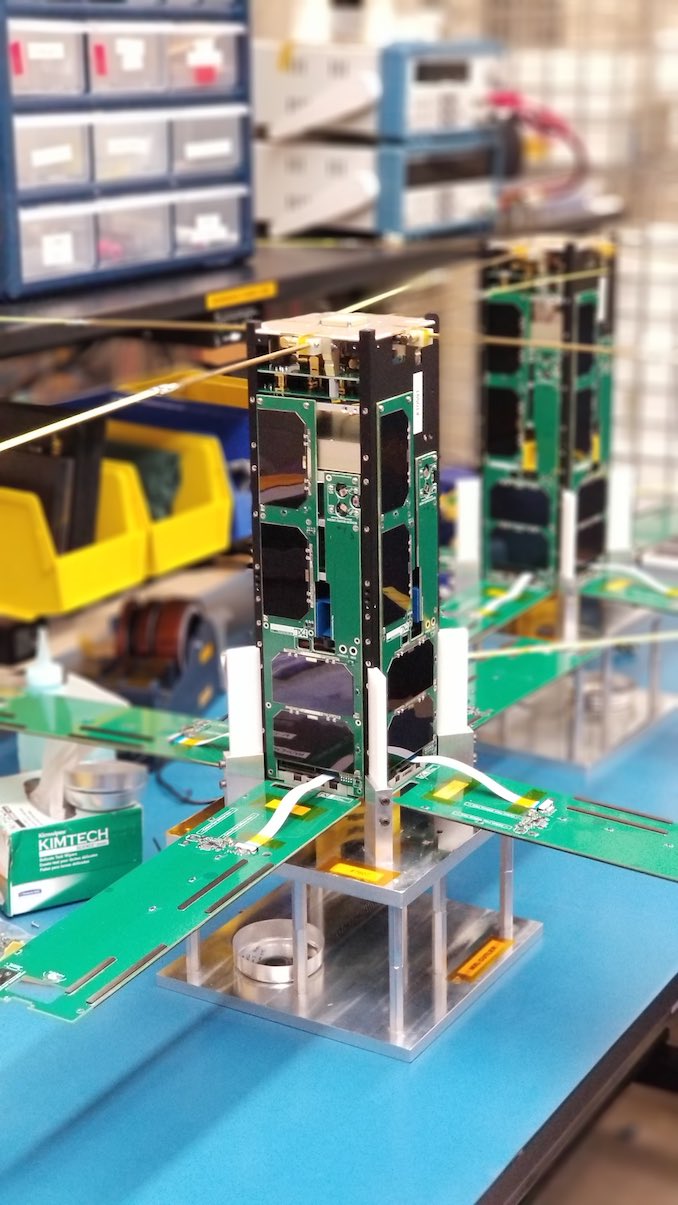
Two NASA-funded CubeSats will also launch on the STP-2 mission to look for hard-to-predict bubbles in a layer of the upper atmosphere called the ionosphere. The Enhanced Tandem Beacon Experiment, or E-TBEx, CubeSats will transmit radio signals down to receiving stations on Earth for scientists to examine how the transmissions are perturbed by disturbances in the ionosphere.
The CubeSats were built at the Michigan Exploration Lab at the University of Michigan in Ann Arbor. Fox said the satellites were relatively inexpensive, with NASA’s investment coming in under $1 million.
“They are just going to be emitting beacons, a beacon tone, so essentially pulsing, and we’ll be looking at how those pulses change as they flow from the CubeSats down to us here on Earth,” Fox said. “If we see any changes, then we know that there are irregularities, and these irregularities actually can cause a lot of problems for GPS signals and communications signals. These are signals, of course, that ships rely on, our armed forces rely on, and we use them increasingly for automatic airplane landings and helping determine where we are during disasters.”
Six COSMIC-2 climate and weather observation satellites jointly developed by Taiwan and NOAA are also launching on the STP-2 mission. Besides their primary function to collect weather data, the COSMIC-2 satellites will also transmit test beacons to Earth to provide scientists greater geographic coverage in their research into ionospheric disturbances.
Email the author.
Follow Stephen Clark on Twitter: @StephenClark1.

